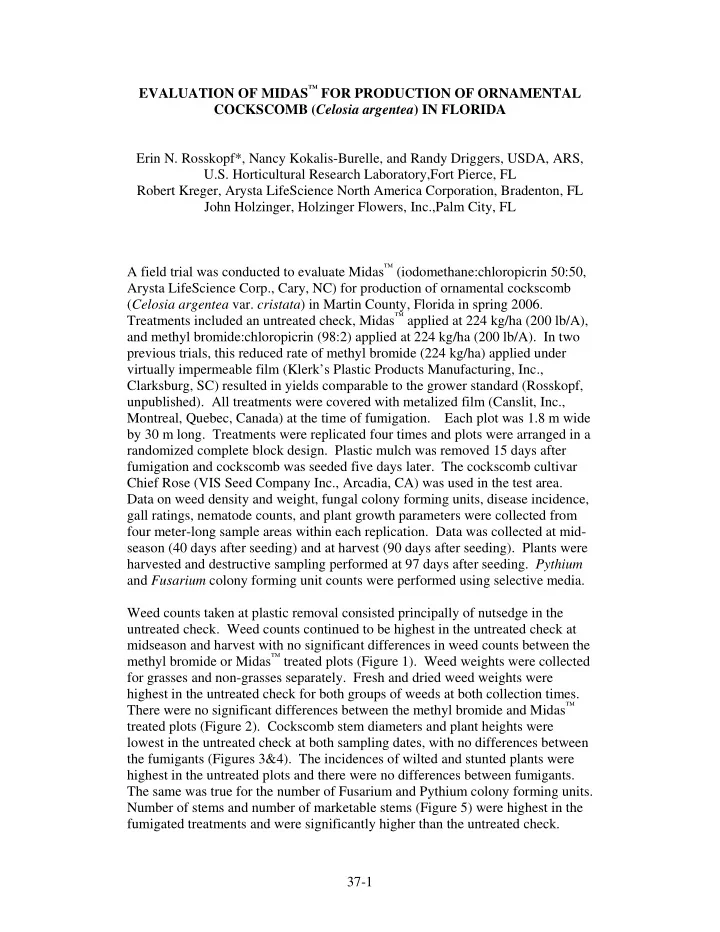

EVALUATION OF MIDAS ™ FOR PRODUCTION OF ORNAMENTAL COCKSCOMB ( Celosia argentea ) IN FLORIDA Erin N. Rosskopf*, Nancy Kokalis-Burelle, and Randy Driggers, USDA, ARS, U.S. Horticultural Research Laboratory,Fort Pierce, FL Robert Kreger, Arysta LifeScience North America Corporation, Bradenton, FL John Holzinger, Holzinger Flowers, Inc.,Palm City, FL A field trial was conducted to evaluate Midas ™ (iodomethane:chloropicrin 50:50, Arysta LifeScience Corp., Cary, NC) for production of ornamental cockscomb ( Celosia argentea var. cristata ) in Martin County, Florida in spring 2006. Treatments included an untreated check, Midas ™ applied at 224 kg/ha (200 lb/A), and methyl bromide:chloropicrin (98:2) applied at 224 kg/ha (200 lb/A). In two previous trials, this reduced rate of methyl bromide (224 kg/ha) applied under virtually impermeable film (Klerk’s Plastic Products Manufacturing, Inc., Clarksburg, SC) resulted in yields comparable to the grower standard (Rosskopf, unpublished). All treatments were covered with metalized film (Canslit, Inc., Montreal, Quebec, Canada) at the time of fumigation. Each plot was 1.8 m wide by 30 m long. Treatments were replicated four times and plots were arranged in a randomized complete block design. Plastic mulch was removed 15 days after fumigation and cockscomb was seeded five days later. The cockscomb cultivar Chief Rose (VIS Seed Company Inc., Arcadia, CA) was used in the test area. Data on weed density and weight, fungal colony forming units, disease incidence, gall ratings, nematode counts, and plant growth parameters were collected from four meter-long sample areas within each replication. Data was collected at mid- season (40 days after seeding) and at harvest (90 days after seeding). Plants were harvested and destructive sampling performed at 97 days after seeding. Pythium and Fusarium colony forming unit counts were performed using selective media. Weed counts taken at plastic removal consisted principally of nutsedge in the untreated check. Weed counts continued to be highest in the untreated check at midseason and harvest with no significant differences in weed counts between the methyl bromide or Midas ™ treated plots (Figure 1). Weed weights were collected for grasses and non-grasses separately. Fresh and dried weed weights were highest in the untreated check for both groups of weeds at both collection times. There were no significant differences between the methyl bromide and Midas ™ treated plots (Figure 2). Cockscomb stem diameters and plant heights were lowest in the untreated check at both sampling dates, with no differences between the fumigants (Figures 3&4). The incidences of wilted and stunted plants were highest in the untreated plots and there were no differences between fumigants. The same was true for the number of Fusarium and Pythium colony forming units. Number of stems and number of marketable stems (Figure 5) were highest in the fumigated treatments and were significantly higher than the untreated check. 37-1
Although the application of Midas ™ required equipment modification that is still being improved, the material provided adequate weed and disease control and produced cockscomb yields that were comparable to methyl bromide. A 35 30 25 total weeds/m 20 15 A 10 B A B 5 B B B B 0 post-fume mid-season harvest UTC MeBr MeI sample time Figure 1. Total number of weeds per meter of row at the time of plastic removal after fumigation (post-fume), mid-season (40 days after seeding), and at harvest (90 days after seeding). Treatments included an untreated check (UTC), methyl bromide:chloropicrin [(MeBr)98:2, 224 kg/ha], and Midas ™ [(MeI) methyl iodide:chloropicrin 50:50, 224 kg/ha). Weeds were harvested from plots at each sampling time. Bars with the same letter, within each sampling time, are not significantly different according to LSD (0.05). 37-2
40 A 35 30 A 25 g/m row weight 20 15 10 B B 5 B B 0 harvest mid-season UTC MeBr MeI sample time Figure 2. Weed dry weights (g) per meter of row mid-season, and harvest. Treatments included an untreated check (UTC), methyl bromide:chloropicrin (MeBr), and Midas ™ (MeI). Bars with the same letter, within each sampling time, are not significantly different according to LSD (0.05). B 12 B 10 stem diameter 8 A mm 6 B B 4 A 2 0 mid-season harvest UTC MeBr MeI sample time Figure 3. Cockscomb stem diameters (mm) at mid-season and harvest. Treatments included an untreated check (UTC), methyl bromide:chloropicrin (MeBr), and Midas ™ (MeI). Bars with the same letter, within each sampling time, are not significantly different according to LSD (0.05). 37-3
B 100 B 90 80 70 A height 60 cm 50 40 30 20 B B A 10 0 harvest mid-season UTC MeBr MeI sample time Figure 4. Cockscomb plant heights (cm) at mid-season and harvest. Treatments included an untreated check (UTC), methyl bromide:chloropicrin (MeBr), and Midas ™ (MeI). Bars with the same letter, within each sampling time, are not significantly different according to LSD (0.05). 80 B 70 B 60 50 stems B 40 A B # 30 20 10 A 0 total stems marketable stems UTC MeBr MeI sample time Figure 5. Total and marketable cockscomb stems. Treatments included an untreated check (UTC), methyl bromide:chloropicrin (MeBr), and Midas ™ (MeI). Bars with the same letter, within each sampling time, are not significantly different according to LSD (0.05). 37-4
Recommend
More recommend